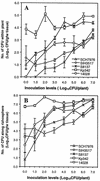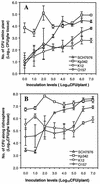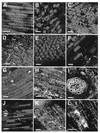Kinetics and strain specificity of rhizosphere and endophytic colonization by enteric bacteria on seedlings of Medicago sativa and Medicago truncatula
- PMID: 12620870
- PMCID: PMC150109
- DOI: 10.1128/AEM.69.3.1783-1790.2003
Kinetics and strain specificity of rhizosphere and endophytic colonization by enteric bacteria on seedlings of Medicago sativa and Medicago truncatula
Abstract
The presence of human-pathogenic, enteric bacteria on the surface and in the interior of raw produce is a significant health concern. Several aspects of the biology of the interaction between these bacteria and alfalfa (Medicago sativa) seedlings are addressed here. A collection of enteric bacteria associated with alfalfa sprout contaminations, along with Escherichia coli K-12, Salmonella enterica serotype Typhimurium strain ATCC 14028, and an endophyte of maize, Klebsiella pneumoniae 342, were labeled with green fluorescent protein, and their abilities to colonize the rhizosphere and the interior of the plant were compared. These strains differed widely in their endophytic colonization abilities, with K. pneumoniae 342 and E. coli K-12 being the best and worst colonizers, respectively. The abilities of the pathogens were between those of K. pneumoniae 342 and E. coli K-12. All Salmonella bacteria colonized the interiors of the seedlings in high numbers with an inoculum of 10(2) CFU, although infection characteristics were different for each strain. For most strains, a strong correlation between endophytic colonization and rhizosphere colonization was observed. These results show significant strain specificity for plant entry by these strains. Significant colonization of lateral root cracks was observed, suggesting that this may be the site of entry into the plant for these bacteria. At low inoculum levels, a symbiosis mutant of Medicago truncatula, dmi1, was colonized in higher numbers on the rhizosphere and in the interior by a Salmonella endophyte than was the wild-type host. Endophytic entry of M. truncatula appears to occur by a mechanism independent of the symbiotic infections by Sinorhizobium meliloti or mycorrhizal fungi.
Figures





References
-
- Anonymous. 1999. Microbiological safety evaluations and recommendations on sprouted seeds. Int. J. Food Microbiol. 52:123-153. - PubMed
-
- Beuchat, L. R., T. E. Ward, and C. A. Pettigrew. 2001. Comparison of chlorine and a prototype produce wash product for effectiveness in killing Salmonella and Escherichia coli O157:H7 on alfalfa seeds. J. Food Prot. 64:152-158. - PubMed
-
- Blattner, F. R., G. Plunkett III, C. A. Bloch, N. T. Perna, V. Burland, M. Riley, J. Collado-Vides, J. D. Glasner, C. K. Rode, G. F. Mayhew, J. Gregor, N. W. Davis, H. A. Kirkpatrick, M. A. Goeden, D. J. Rose, B. Mau, and Y. Shao. 1997. The complete genome sequence of Escherichia coli K-12. Science 277:1453-1474. - PubMed
Publication types
MeSH terms
LinkOut - more resources
Full Text Sources
Other Literature Sources

